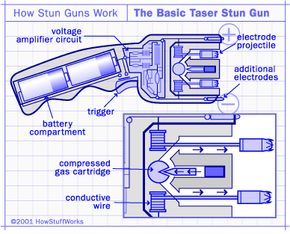Flying Tasers
One popular variation on the conventional stun-gun design is the Taser gun. Taser guns work the same basic way as ordinary stun guns, except the two charge electrodes aren't permanently joined to the housing. Instead, they are positioned at the ends of long conductive wires, attached to the gun's electrical circuit. Pulling the trigger breaks open a compressed gas cartridge inside the gun. The expanding gas builds pressure behind the electrodes, launching them through the air, the attached wires trailing behind. (This is the same basic firing mechanism as in a BB gun.)
The electrodes are affixed with small barbs so that they will grab onto an attacker's clothing. When the electrodes are attached, the current travels down the wires into the attacker, stunning him in the same way as a conventional stun gun.
Advertisement
The main advantage of this design is that you can stun attackers from a greater distance (typically 15 to 20 feet / 4 to 6 meters). The disadvantage is that you only get one shot -- you have to wind up and re-pack the electrode wires, as well as load a new gas cartridge, each time you fire. Most Taser models also have ordinary stun-gun electrodes, in case the Taser electrodes miss the target.
Some Taser guns have a built in shooter-identification system. When a police officer fires the Taser electrodes, the gun releases dozens of confetti-sized identification tags. These tags tell investigators which gun was fired, at what location. Some Taser guns also have a computer system that records the time and of every shot.
Tasers are only one way to conduct current over greater distances. In the next section, we'll look a relatively new long-range stun weapon that doesn't use any wires at all.
